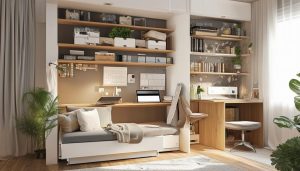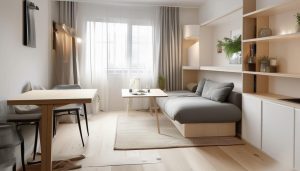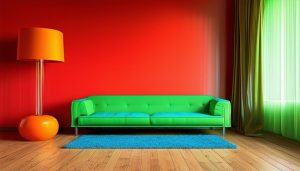
Table of Contents
ToggleBlending Styles: Creating a Harmonious Fusion
When it comes to design, the concept of blending styles plays a crucial role in achieving seamless integration. Blending styles involves combining different design elements, aesthetics, or influences to create a harmonious fusion that is visually appealing and functional.
By blending styles, designers can break away from traditional design boundaries and create unique and captivating experiences for their audience. It allows for the exploration of diverse design elements, such as mixing modern and vintage styles, combining minimalism with bold colors, or incorporating elements from different cultural influences.
One of the key benefits of blending styles in design is the ability to create a harmonious fusion that appeals to a wider audience. By incorporating elements from different styles, designers can cater to various tastes and preferences, making their designs more inclusive and relatable. This approach also allows for the creation of visually striking designs that capture attention and leave a lasting impression.
Successful examples of blending styles can be found in various industries, from interior design to fashion and graphic design. For instance, in interior design, blending contemporary and rustic styles can create a warm and inviting space that combines modern comfort with a touch of natural charm. In fashion, blending traditional and avant-garde elements can result in innovative and eye-catching outfits that push the boundaries of style.
When approaching blending styles, it is essential to strike a balance between the different elements. The goal is to create a cohesive and seamless integration where the different styles complement each other rather than clash. This requires careful consideration of color palettes, textures, shapes, and overall composition.
In conclusion, blending styles is an effective approach to achieve seamless integration in design. By combining different design elements and aesthetics, designers can create a harmonious fusion that appeals to a wider audience and captures attention. It allows for the exploration of unique and captivating design experiences that break away from traditional boundaries. So, embrace the power of blending styles and unlock the potential for stunning and cohesive design.
Transitional Harmony: Achieving Cohesive Design
Transitional harmony is a fundamental concept in design that focuses on achieving a cohesive and seamless integration of elements. It involves the careful transition between different design elements, styles, or components to create a harmonious and visually pleasing composition.
When it comes to seamless integration, transitional harmony plays a crucial role. It ensures that all the elements in a design work together cohesively, creating a unified and balanced aesthetic. By achieving transitional harmony, designers can guide the viewer’s eye smoothly throughout the design, creating a sense of flow and continuity.
One of the key aspects of transitional harmony is the smooth transition between different styles or design elements. This can be achieved through the use of complementary colors, shapes, or textures that seamlessly blend together. For example, in interior design, transitional harmony can be achieved by combining modern furniture with traditional architectural details, creating a space that feels cohesive and balanced.
Another important consideration in achieving transitional harmony is the overall composition of the design. This involves the careful arrangement of elements and the establishment of a visual hierarchy. By organizing the design in a way that guides the viewer’s attention, designers can create a sense of order and balance.
Transitional harmony is also closely related to the concept of rhythm and repetition in design. By repeating certain elements or patterns throughout the design, designers can create a sense of unity and harmony. This can be seen in graphic design, where the repetition of shapes or patterns can create a cohesive and visually appealing composition.
In conclusion, achieving transitional harmony is essential for creating a cohesive and seamless design. By carefully transitioning between different design elements, organizing the composition, and establishing a visual hierarchy, designers can create a harmonious and visually pleasing aesthetic. So, embrace the power of transitional harmony and unlock the potential for cohesive and captivating design.
Integrated Elements: Enhancing Seamless Flow
In the realm of design, the integration of elements is a key factor in achieving a seamless flow and cohesive aesthetic. Integrated elements refer to the intentional combination of different design components, such as colors, typography, imagery, and layout, to create a unified and visually pleasing composition.
By incorporating integrated elements, designers can enhance the overall user experience and create a sense of harmony and balance. When elements are seamlessly integrated, they work together cohesively, guiding the viewer’s eye and creating a smooth flow throughout the design.
One of the ways to achieve integrated elements is through the use of a consistent color palette. By selecting a cohesive range of colors that complement each other, designers can create a harmonious visual experience. This can be seen in branding, where companies often use a consistent color scheme across various touchpoints to create a unified and recognizable brand identity.
Typography is another important aspect of integrated elements. By selecting and combining fonts that work well together, designers can establish a cohesive typographic hierarchy that enhances readability and visual appeal. The careful integration of typography ensures that the text elements seamlessly blend with the overall design.
Furthermore, the integration of imagery plays a significant role in creating a cohesive visual experience. By selecting and placing images strategically, designers can enhance the message of the design and create a seamless connection between the visual and textual elements. The integration of imagery can evoke emotions, convey information, and enhance the overall aesthetic.
In conclusion, integrated elements are vital in enhancing the seamless flow and cohesive design. By intentionally combining different design components, such as colors, typography, and imagery, designers can create a unified and visually pleasing composition. The integration of elements ensures a harmonious visual experience and guides the viewer’s eye throughout the design. So, embrace the power of integrated elements and unlock the potential for a seamless and captivating design.
Smooth Transitions: Creating a Balanced Composition
In the world of design, smooth transitions are essential for creating a balanced and visually pleasing composition. Smooth transitions refer to the seamless flow between different design elements, allowing for a harmonious and cohesive design.
When it comes to seamless integration, smooth transitions play a crucial role. They guide the viewer’s eye smoothly throughout the design, creating a sense of flow and continuity. By achieving smooth transitions, designers can create a visually pleasing composition that captures attention and leaves a lasting impression.
One of the key aspects of smooth transitions is the careful consideration of color palettes. By selecting colors that complement each other and transitioning between them seamlessly, designers can create a harmonious visual experience. Smooth color transitions can evoke different emotions and set the tone for the design.
Another important consideration in achieving smooth transitions is the use of shapes and lines. By incorporating curves and fluid lines, designers can create a sense of movement and flow. The smooth transition between shapes and lines can add visual interest and create a dynamic composition.
Texture is also a powerful tool in creating smooth transitions. By incorporating different textures and transitioning between them smoothly, designers can add depth and dimension to the design. Texture transitions can create visual contrast and enhance the overall aesthetic.
In conclusion, smooth transitions are crucial for creating a balanced and visually pleasing composition. By carefully considering color palettes, shapes, lines, and textures, designers can achieve a seamless flow that guides the viewer’s eye throughout the design. Smooth transitions add visual interest and create a harmonious visual experience. So, embrace the power of smooth transitions and unlock the potential for a captivating and balanced design.
Unified Look: Merging Aesthetics and Functionality
When it comes to design, achieving a unified look is crucial for seamless integration. A unified look refers to the intentional merging of aesthetics and functionality to create a cohesive and visually appealing design. It involves considering both the visual aspects and the practical aspects of a design to ensure a harmonious and balanced composition.
By merging aesthetics and functionality, designers can create a design that not only looks visually pleasing but also serves its intended purpose effectively. This approach takes into account the user experience and ensures that the design is not only visually appealing but also functional and user-friendly.
One of the key benefits of a unified look is that it creates a sense of coherence and consistency. When aesthetics and functionality are seamlessly integrated, the design feels cohesive and well-thought-out. It creates a positive impression and enhances the overall user experience.
A unified look can be achieved through various design strategies. For example, the use of consistent branding elements, such as colors, typography, and imagery, can create a cohesive visual identity across different touchpoints. This helps to establish brand recognition and reinforces the brand’s message.
Additionally, the careful selection and placement of design elements can contribute to a unified look. By considering the purpose and function of each element, designers can ensure that they work together harmoniously. This includes factors such as the placement of navigation menus, the arrangement of content, and the use of whitespace.
In conclusion, merging aesthetics and functionality is essential for achieving a unified look in design. By considering both the visual aspects and the practical aspects, designers can create a cohesive and visually appealing design that serves its intended purpose effectively. A unified look enhances the overall user experience and creates a positive impression. So, embrace the power of merging aesthetics and functionality and unlock the potential for a seamless and captivating design.
Merging Aesthetics: Creating a Unified Look
In the world of design, merging aesthetics is a key element in creating a unified look. Merging aesthetics refers to the intentional combination of different visual elements, such as colors, shapes, textures, and typography, to create a cohesive and visually appealing design.
When aesthetics are merged effectively, they work together harmoniously to create a unified look that is visually pleasing and engaging. By merging aesthetics, designers can create a unique and distinctive visual identity that reflects the brand or the intended message of the design.
One of the key benefits of merging aesthetics is the ability to create a cohesive and memorable brand identity. By combining different visual elements, designers can establish a consistent and recognizable look that sets the brand apart. This helps to create a strong and lasting impression in the minds of the audience.
Moreover, merging aesthetics allows designers to evoke specific emotions or convey certain messages through the visual language of the design. By carefully selecting and combining colors, shapes, and typography, designers can create a design that resonates with the target audience and effectively communicates the desired message.
When merging aesthetics, it is important to consider the overall composition and balance of the design. Each visual element should complement and enhance the others, creating a harmonious and visually appealing composition. This can be achieved through the careful placement of elements, the use of whitespace, and the establishment of a visual hierarchy.
In conclusion, merging aesthetics is a crucial aspect of creating a unified look in design. By intentionally combining different visual elements, designers can establish a cohesive and visually appealing design that reflects the brand or the intended message. Merging aesthetics allows for the creation of a strong and memorable brand identity and enables effective communication with the target audience. So, embrace the power of merging aesthetics and unlock the potential for a unified and captivating design.
Integrated Functionality: Seamlessly Combining Design and Purpose
Integrated functionality is a crucial aspect of design that focuses on seamlessly combining aesthetics with purpose. It involves the intentional integration of design elements and features that enhance the usability and functionality of a product or design.
When it comes to seamless integration, integrated functionality plays a vital role. It ensures that the design not only looks visually appealing but also serves its intended purpose effectively. By integrating functionality, designers can create a design that is both aesthetically pleasing and highly functional.
One of the key benefits of integrated functionality is the enhanced user experience. By considering the usability and functionality of a design, designers can create a seamless and intuitive user experience. This can be achieved through the thoughtful placement and interaction of elements, clear navigation, and intuitive user interfaces.
Moreover, integrated functionality allows designers to optimize the design for specific purposes or target audiences. By understanding the needs and preferences of the users, designers can incorporate features and functionalities that cater to their requirements. This can result in a design that is tailored to the needs of the users, enhancing their overall satisfaction.
When integrating functionality, it is important to strike a balance between aesthetics and usability. The design should not only look visually appealing but also be practical and user-friendly. This requires careful consideration of factors such as accessibility, responsiveness, and ease of use.
In conclusion, integrated functionality is essential for creating a design that seamlessly combines aesthetics with purpose. By integrating functionality, designers can enhance the user experience and create a design that is both visually appealing and highly functional. Integrated functionality allows for the optimization of the design for specific purposes or target audiences, resulting in a tailored and satisfying user experience. So, embrace the power of integrated functionality and unlock the potential for a design that seamlessly combines form and function.
In conclusion, achieving seamless integration through blending styles, transitional harmony, integrated elements, smooth transitions, unified look, merging aesthetics, and integrated functionality is essential for creating cohesive and visually appealing designs. By carefully considering and merging these elements, designers can create designs that not only look visually pleasing but also function effectively, providing a seamless and engaging user experience.
FAQs
1. How can I achieve a seamless flow in my design?
To achieve a seamless flow in your design, consider factors such as color palettes, typography, and layout. Ensure that these elements transition smoothly and create a sense of harmony and continuity throughout the design.
2. What is the importance of transitional harmony in design?
Transitional harmony is important in design as it creates a cohesive and visually pleasing composition. It ensures that all the elements work together harmoniously and guide the viewer’s eye smoothly throughout the design.
3. How can I create a unified look in my design?
To create a unified look, merge aesthetics and functionality. Consider both the visual aspects and the practical aspects of your design, ensuring that they work together cohesively to create a harmonious and balanced composition.
4. Why is integrated functionality important in design?
Integrated functionality is important in design as it enhances the user experience and ensures that the design serves its intended purpose effectively. By integrating functionality, designers can create designs that are both visually appealing and highly functional.
5. How can I merge aesthetics effectively in my design?
To merge aesthetics effectively, carefully select and combine different visual elements such as colors, shapes, textures, and typography. Ensure that these elements work together harmoniously to create a cohesive and visually appealing design.





